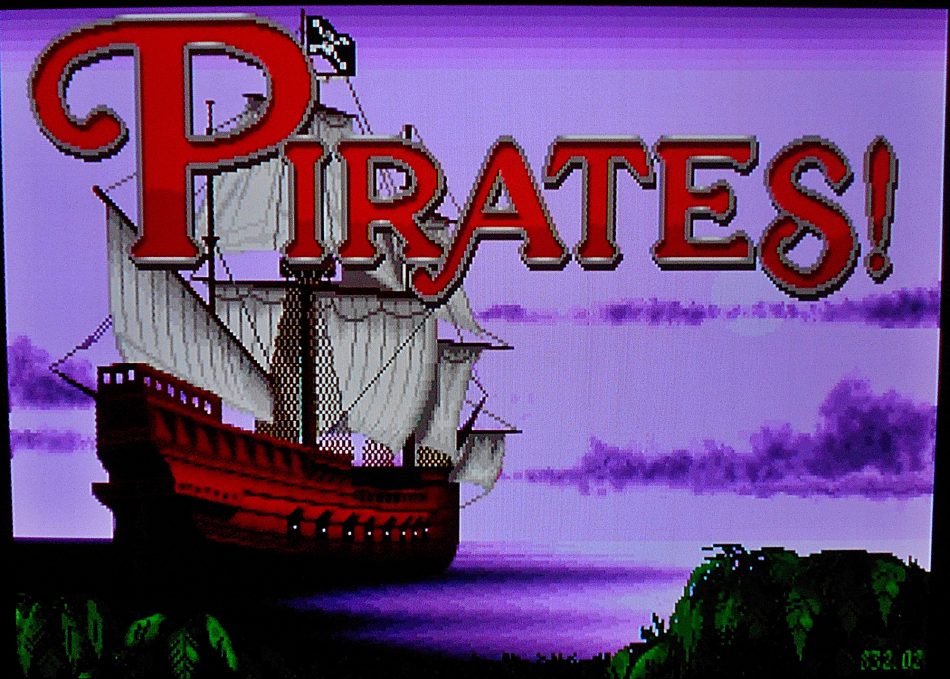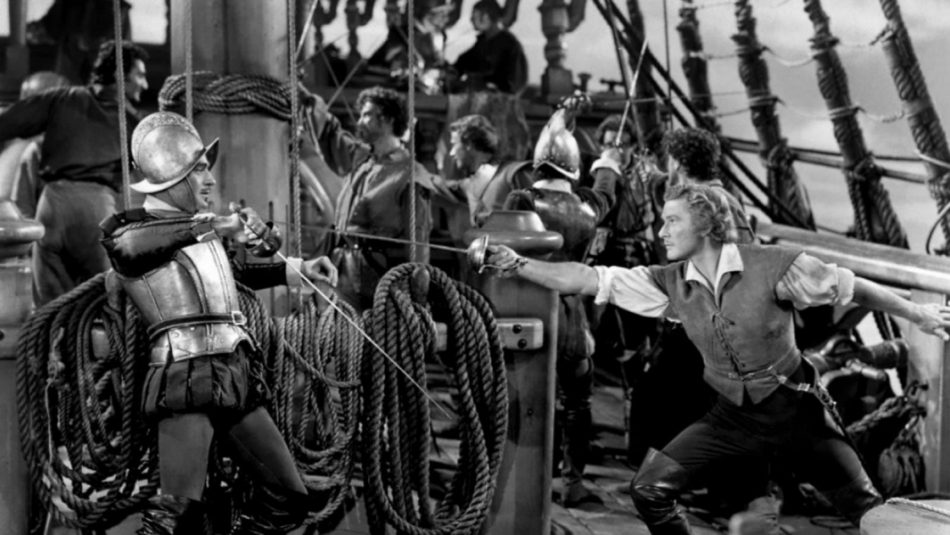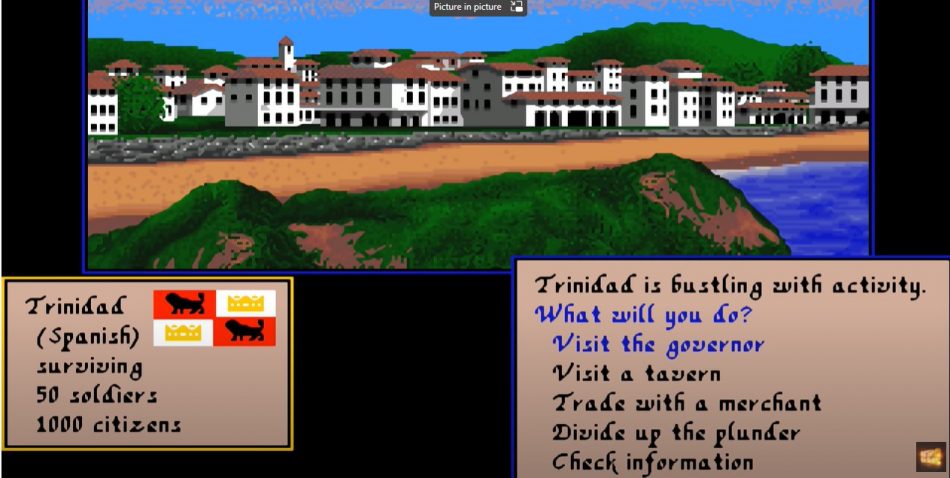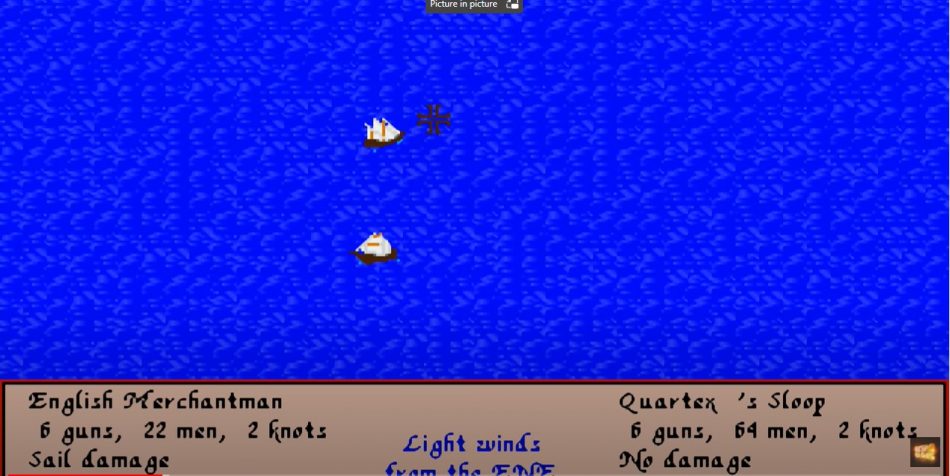Retrospective of Sid Meier’s Pirates!
By Patrick S. Baker

Yo ho, yo ho, a pirate’s life for me
We pillage, we plunder, we rifle, and loot
Drink up, me ‘earties, yo ho
We kidnap and ravage and don’t give a hoot
Drink up me ‘earties, yo ho
–From Yo Ho (A Pirate’s Life for Me), by George Bruns
In 1982 Sid Meier and Bill Stealey founded MicroProse and by 1986 the video game company was highly successful by largely focusing on military and vehicle simulations such as Chopper Rescue, Spitfire Ace, and Silent Service. But Meier, MicroProse’s chief designer and programmer, had grown bored with the hyper-realistic games and wanted to do something different.
In a meeting with Arnold Hendricks, a MicroProse programmer, Meier heard the pitch for a pirate game. The game was pitched as an “Age of Sail” ship-to-ship combat game, much like Avalon Hill’s Clear for Action. Meier liked the idea but wanted it to be an open-world adventure game, not just a combat simulation. Meier later wrote: “Pirates didn’t spend all day fighting one another. Pirates had adventures.”
Shortly after this meeting Meier and his new girlfriend went on a romantic vacation to the Caribbean. While in the islands Meier disappeared for hours causing his girlfriend to rightly panic, fearing he had drowned or been kidnapped by drug dealers. Meier turned up later explaining he had lost track of time as he had become entranced by the relics in the local pirate history museum. The relationship survived this “bad boyfriend” behavior and the couple later married.
 Meier was now more determined than before to produce an adventure game about pirates. Stealey was not enthusiastic about the idea. According to Meier, when he pitched the game to Stealey, Stealey said: “Pirates? Wait a minute, there are no airplanes in pirates. Wait a minute, you can’t do that.” Stealey’s disapproval of the concept was the result of his preoccupation with the modern military simulations on which MicroProse’s success was built and he had no wish to dilute the brand or have his partner and best designer waste time and resources on a new thing that could very well flop.
Meier was now more determined than before to produce an adventure game about pirates. Stealey was not enthusiastic about the idea. According to Meier, when he pitched the game to Stealey, Stealey said: “Pirates? Wait a minute, there are no airplanes in pirates. Wait a minute, you can’t do that.” Stealey’s disapproval of the concept was the result of his preoccupation with the modern military simulations on which MicroProse’s success was built and he had no wish to dilute the brand or have his partner and best designer waste time and resources on a new thing that could very well flop.
However, Meier could be remarkably stubborn about what he wished to work on and plowed ahead with the game’s development. Stealey could do nothing to stop him. Still, Stealey did convince Meier to develop the game for the Commodore 64 instead of the old and fading Atari 8-bit machine.
 Meanwhile, Gregg Tavares, a MicroProse programmer had developed a way to wrap text or menus or graphics into windows and place them on the screen quickly and easily for the Commodore 64 system. Meier said, “We had this way of bringing the game to life in a series of pictures and text…”
Meanwhile, Gregg Tavares, a MicroProse programmer had developed a way to wrap text or menus or graphics into windows and place them on the screen quickly and easily for the Commodore 64 system. Meier said, “We had this way of bringing the game to life in a series of pictures and text…”
There are two stories about how the game became Sid Meier’s Pirates!. The first story is that the game was just titled, Pirates! but, according to Meier, Stealey quickly became troubled about MicroProse working on this “off-brand” game and was convinced it would crash and burn, so he told Meier: “Well, we should at least put your name on it…Then maybe the people who liked F-15 will recognize it’s you and buy it anyway.”
The other, more interesting story, was that Stealey met legendary actor and comedian Robin Williams at a function, and they got to talking about video games. During this conversation, Williams said, “Bill, you should put Sid’s name on a couple of these boxes and promote him as the star.” Both stories could well be true, in any case, Sid Meier’s name was added to the title of Pirates! and other subsequent games, arguably turning Meier into the most famous game designer in the world.
 Meier in no way wanted to try and make Pirates! a simulation of real pirates’ lives. Thinking correctly that few people would want to play a game that replicated a short life with long periods of boredom, brutal violence, terrible diseases, and likely ending with a trip to the gallows. Instead, Meier focused on the romantic versions of pirates he recalled from watching films like Captain Blood and The Sea Hawk.
Meier in no way wanted to try and make Pirates! a simulation of real pirates’ lives. Thinking correctly that few people would want to play a game that replicated a short life with long periods of boredom, brutal violence, terrible diseases, and likely ending with a trip to the gallows. Instead, Meier focused on the romantic versions of pirates he recalled from watching films like Captain Blood and The Sea Hawk.
 Still, there had to be some historicity in the game. Once Meier had the design far enough along Hendrick rejoined the project as a researcher and “reality advocate”. Hendrick’s historical input added a lot to the game. For example, he examined the attributes of the nine different ships available in the game, which included the differences in the sailing qualities of square-rigged ships compared to fore-and-aft-rigged ships.
Still, there had to be some historicity in the game. Once Meier had the design far enough along Hendrick rejoined the project as a researcher and “reality advocate”. Hendrick’s historical input added a lot to the game. For example, he examined the attributes of the nine different ships available in the game, which included the differences in the sailing qualities of square-rigged ships compared to fore-and-aft-rigged ships.
Further, the geography of the Caribbean was accurately presented in the game. In later years MicroProse often heard from students who had astounded their teachers with their knowledge of Caribbean geography thanks to Pirates!.
At some point, Meier decided that the player could not lose the game. The player could do badly or well, but the player does not die. So, if the player loses a sword fight, they are captured and imprisoned, but later escape. If the player’s ship sinks, the player washes ashore on a deserted island but is eventually rescued. However, that doesn’t mean that the game is easy. The relative difficulty of the game is determined by two factors, the… ah… “Difficulty Level” and the player’s age in the game.
As the game progresses, the player ages, and as they age, they slow down. So, they become more likely to lose a sword fight or be defeated in ship-to-ship combat. Ultimately, the player sells his loot and ship, pays off his crew, retires with as much money, titles, and land as they can, and, with any luck, also marry a colonial governor’s beautiful daughter.
 Released in 1987 for the Commodore 64, Apple II, and IBM PC, by 1991 Pirates! had been ported to the Mac, PC-88, Atari ST, Amiga, and NES systems.
Released in 1987 for the Commodore 64, Apple II, and IBM PC, by 1991 Pirates! had been ported to the Mac, PC-88, Atari ST, Amiga, and NES systems.
Reviews were enthusiastic. A 1987 review praised the gameplay elements, with one reviewer calling it “a real treasure.” Dragon, one of two official magazines for source material for the Dungeons & Dragons gave the game 5 out of 5 stars and called it an “ingenious and exciting game…that combines the fun of an action-arcade game, adventure game, sailing simulation, and role-playing game all in one offering.”
Pirates! also won two Origins Awards. One as “Best Fantasy or Science Fiction Computer Game of 1987” as well as “Best Screen Graphics in a Home Computer Game of 1987”. Computer Gaming World named Pirates! “Action Game of the Year” for 1988. Science fiction author, Orson Scott Card said in the April 1989 issue of Compute! that “the game is so good that even …” law-abiding people “…might consider stealing it”. Also, in 1989 Computer Gaming World put Pirates! to its Hall of Fame with a score of 9.71 out of 12, and Compute! gave the game the magazine’s Choice Award for Historical Game.
As the game was ported to new systems, magazines dedicated to those systems reviewed it as well, as did international audiences. Australia’s Amstrad Action called Pirates! “Excellent swashbuckling stuff…” and gave it a 76% score. The Australian Commodore and Amiga Review, Commodore Annual for 1989 called it both “fun” and “educational”.
 Germany’s Amiga Joker magazine gave the game 16.5 out of 20 in 1990. Also, in 1990 Computer Gaming World awarded the game 5 out of 5 stars in a survey of historical strategy and war games. That same year Pirates! ranked tenth overall in a survey of the magazine’s readership for “All-Time Favorite Game”.
Germany’s Amiga Joker magazine gave the game 16.5 out of 20 in 1990. Also, in 1990 Computer Gaming World awarded the game 5 out of 5 stars in a survey of historical strategy and war games. That same year Pirates! ranked tenth overall in a survey of the magazine’s readership for “All-Time Favorite Game”.
Oddly for such a successful game, no sequels were produced, but two remakes were developed, one in 1993, titled Sid Meier’s Pirates! Gold and another in 2004 called just Sid Meier’s Pirates!.
Sources:
Academy of Adventure Gaming Arts & Design, Origins Awards “1987 List of Winners“.
Australian Commodore and Amiga Review, The: Commodore Annual (1989)
Card, Orson Scott. Compute! (April 1989). “Gameplay”
Computer Gaming World October 1988, May 1989, January 1990, and October 1990
Dragon (April 1988) “The Role of Computers”.
Meier, Sid with Jennifer Lee Noonan, Sid Meier’s Memoir!: A Life in Computer Games (New York: W. W. Norton, Co. 2020)
“Pirates!”. (October 1987). Compute’s Gazette
Pirates! at The Digital Antiquarian
“Pirates!”(July, 1990) Amiga Joker..
“Pirates!” (May, 1988. Amstrad Action
Sid Meier’s Pirates! at the Retroist
